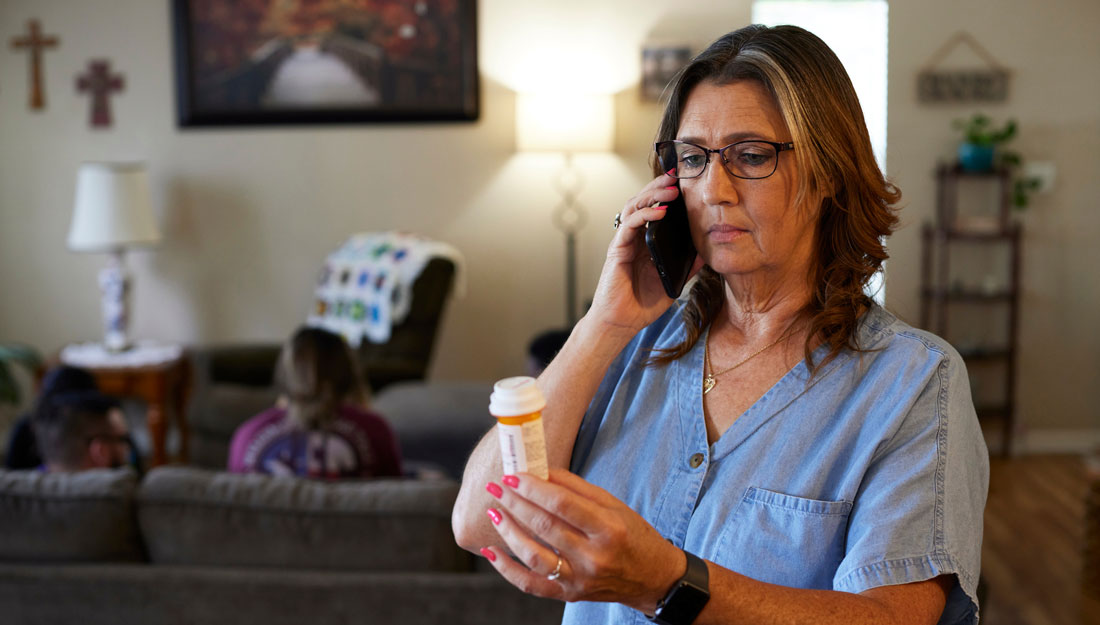- Lindsey Hendrix
- Health Tips, Healthy Living, Pharmacy, Show on VR homepage
Medication side effects: What to do if you have an adverse drug reaction
From minor to life-threatening, know what to look for and what to do if you suspect a medication side effect

If you are about to start a new medication and are concerned about potential side effects, ask your doctor or pharmacist about symptoms to look out for and what to do if they occur. Photo Texas A&M Health
Medications improve and extend life for millions of people, with some even considering them miraculous. Yet, despite their numerous benefits, the risk remains for side effects, also known as adverse drug reactions (ADRs), that can range from mild to life-threatening.
According to the U.S. Food and Drug Administration (FDA), there are more than 2.2 million serious ADRs in hospitalized patients, causing over 106,000 deaths annually. If these estimates are accurate, then ADRs are the fourth leading cause of death—ahead of pulmonary disease, diabetes, AIDS, pneumonia, accidents and automobile deaths.
March 24 is National Adverse Drug Event Awareness Day, which was created by the American Society of Pharmacovigilance to raise awareness of these startling statistics and encourage health care professionals and patients to diligently practice medication safety. We spoke with co-founder of the American Society of Pharmacovigilance, Sara Rogers, PharmD, clinical assistant professor at the Texas A&M Irma Lerma Rangel School of Pharmacy, to learn more about the signs to look for and actions to take in the case of an ADR.
Anaphylaxis comes to mind as what would be a major adverse reaction. What are some others?
Anaphylaxis is a severe, potentially life-threatening allergic reaction. It is one of many adverse drug reactions a patient can have, which is defined as “harm directly caused by a drug at normal doses.”
An adverse drug event, on the other hand, broadly encompasses harm that occurs during medical care that is directly caused by the drug due to medication errors, adverse drug reactions, allergic reactions and overdoses, to name a few. A medication error is the “inappropriate use of a drug that may or may not result in harm” and may occur during prescribing, transcribing, dispensing, administering, adherence or monitoring of a drug. Organizations like the Institute of Safe Medicine Practices (ISMP) focus exclusively on preventing medication errors, in part, by setting best practices to prevent errors.
What are signs that someone is having a bad or unintended reaction to a drug?
Side effects can differ for each individual depending on the medical condition. A person’s age, weight, gender, ethnicity and other factors can play a role as well. Many different signs and symptoms are possible and could indicate that someone is having a bad or unintended reaction to a drug. This can vary substantially between medications. A few examples of adverse drug reactions are:
- Incontinence
- Dizziness
- Hypertension
- Movement disorder
- Cough
- Tremor
- Arrhythmia
- Rash
- Nausea
- Involuntary movements
The FDA maintains a database that contains side effects for thousands of drugs and can be accessed online.
What can be done if someone has an adverse reaction to a drug?
Adverse reactions to a drug can happen at any time. They can occur when you first take a medicine, with changes in dosage, or if you stop taking the medicine suddenly or too soon. If you begin to take other prescriptions or non-prescription products, interactions among the medicines may cause side effects as well. Adverse reactions can also occur when using medical devices, dietary supplements, infant formula, cosmetics and biologic products such as vaccines, blood and blood components, gene therapy, tissues, allergenics and somatic cells.
If you think you or someone in your family has experienced a serious reaction to a medical product, you are encouraged to take the FDA’s MedWatch reporting form to your doctor. Your health care provider can provide clinical information based on your medical record that can help the FDA evaluate your report. You may also complete the online reporting form yourself.
If you are about to start a new medication and are concerned about potential side effects, ask your doctor or pharmacist about symptoms to look out for and what to do if they occur. Always ask if there are any patient education printouts you can review.
How might an adverse reaction be treated?
Treatment for an adverse reaction will depend on many factors, but below are a few commonly encountered drug-related side effects and suggestions for their management as examples.
Allergic reactions potentially could occur with any medication. Symptoms range from a mild rash to a severe anaphylactic reaction (including facial and throat swelling, difficulty breathing and a widespread rash). Take an antihistamine and see a doctor straight away if you think you are having an allergic reaction to a medicine. Seek emergency help if the reaction is severe.
Bruising and bleeding are common with medicines that “thin the blood” such as aspirin, clopidogrel, enoxaparin and warfarin. This is also common with NSAIDs, steroids (such as prednisone) and certain medicines used to treat cancer. Try to avoid bumping yourself into furniture. Remove any trip hazards, such as loose rugs. Seek emergency help if you have a wound that bleeds profusely or doesn’t stop bleeding within 15 minutes.
Tendonitis or tendon rupture is most commonly reported with fluoroquinolone antibiotics (for example, ciprofloxacin norfloxacin, ofloxacin, levofloxacin). Discontinue the antibiotic immediately if you experience pain or swelling in a tendon and report this information to your doctor. Avoid all fluoroquinolones in the future if you develop a tendon problem while taking a fluoroquinolone.
What role does pharmacogenomics play in limiting the chances of bad reactions to drugs?
Pharmacogenetics is the study of how your genes influence your reaction to drugs. Genetic factors account for 20 to 95 percent of variability in patients’ response to treatment. This field of pharmacogenomics is rapidly evolving, and testing for liver enzyme variations is becoming more widespread. For example, codeine requires metabolism through a protein coding gene called CYP2D6 for conversion to one of its active metabolites, morphine. An estimated 5 to 10 percent of people are poor metabolizers, which means that in these people, very little codeine is converted to morphine which results in insufficient pain relief. However, 1 to 2 percent of people are ultra-rapid metabolizers and more codeine is converted into morphine than normal, resulting in a higher risk of toxic reactions including respiratory depression.
Advancements in pharmacogenetics has the potential to not only drastically improve effectiveness of pharmaceutical therapy but could also reduce the number of adverse drug reactions. While progress is being made, it’s still critical that we all do our part in medication safety.
Media contact: media@tamu.edu


